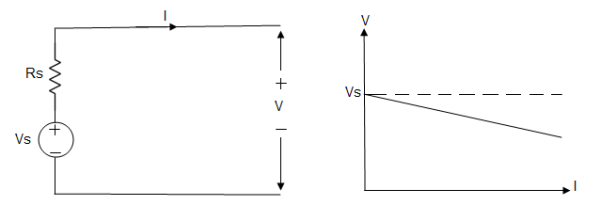Unit 1
Contents
DC Circuits:
1.1 Electrical circuit elements (R, L and C)
The three essential elements in circuit analysis: • Resistance R • Capacitance C • Inductance L
Their V and I relationships are summarized below
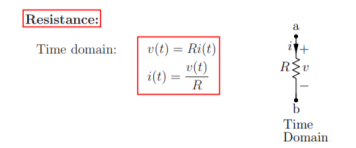
Resistance is a static element in the sense v(t) versus i(t) relationship is instantaneous. For example, v(t) at time t = 2 seconds simply depends only on i(t) at t = 2 seconds and nothing else. This implies that the resistance does not know what happened in the past, in other words it does not store any energy unlike other elements C and L.
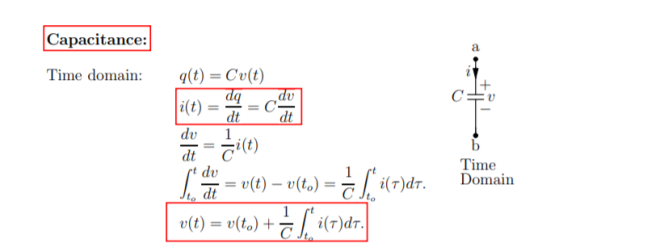
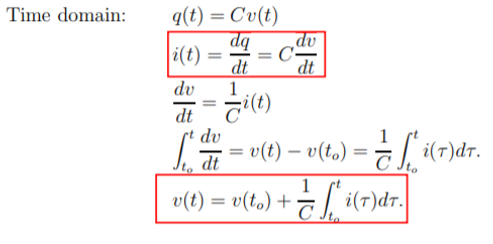
Capacitance: Time domain:
q(t) = Cv(t)
i(t) = dq /dt = C dv/ dt
Dv/dt = 1/C i(t)
  
For a capacitance the v(t) versus i(t) relationship and vice versa at any time t depends on the past as they involve differentials and integrals. This implies that the capacitance is a dynamic element.
Inductance:

Time domain v(t) = L di/dt
Di/dt = 1/L v(t)  
i(t) = i(to) + 1/L 
1.2 Voltage and current sources
Ideal and practical Voltage and Current source: A voltage source is a device which provides a constant voltage to load at any instance of time and is independent of the current drawn from it. This type of source is known as an ideal voltage source. Practically, the ideal voltage source cannot be made. It has zero internal resistance. It is denoted by this symbol. 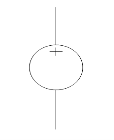 Fig: Voltage source symbol
Ideal Voltage Source 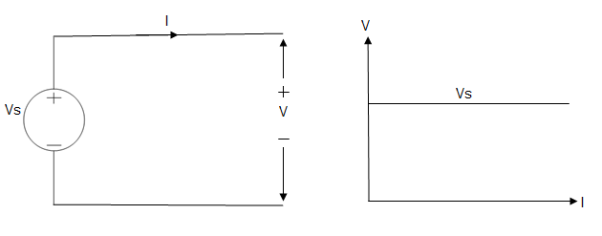 Fig: Ideal Voltage Source
The graph represents the change in voltage of the voltage source with respect to time. It is constant at any instance of time. Voltage sources that have some amount of internal resistance are known as a practical voltage source. Due to this internal resistance, voltage drop takes place. If the internal resistance is high, less voltage will be provided to load and if the internal resistance is less, the voltage source will be closer to an ideal voltage source. A practical voltage source is thus denoted by a resistance in series which represents the internal resistance of source.
Practical Voltage source 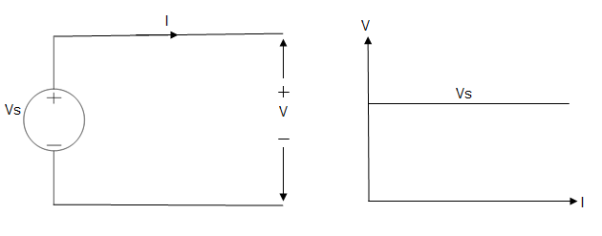 Fig: Practical Voltage source
The graph represents the voltage of the voltage source with respect to time. It is not constant but it keeps on decreasing as the time passes.
Current source A current source is a device which provides the constant current to load at any time and is independent of the voltage supplied to the circuit. This type of current is known as an ideal current source; practically ideal current source is also not available. It has infinite resistance. It is denoted by this symbol.
Ideal Current source 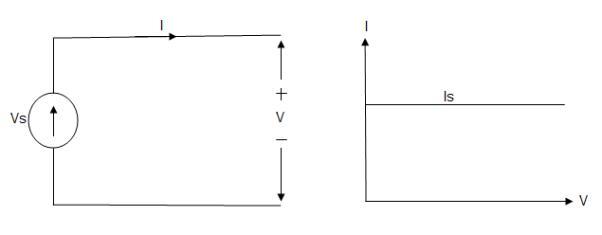 Fig: Ideal Current source
The graph represents the change in current of the current source with respect to time. It is constant at any instance of time.
Why ideal Current source has infinite resistance?
A current source is used to power a load, so that load will turn on. We try to supply 100% of the power to load. For that, we connect some resistance to transfer 100% of power to load because the current always takes the path of least resistance. So, in order for current to go to the path of least resistance, we must connect resistance higher than load. This is why we have the ideal current source to have infinite internal resistance. This infinite resistance will not affect voltage sources in the circuit.
Practical Current source Practically current sources do not have infinite resistance across there but they have a finite internal resistance. So the current delivered by the practical current source is not constant and it is also dependent somewhat on the voltage across it.
A practical current source is represented as an ideal current source connected with resistance in parallel. 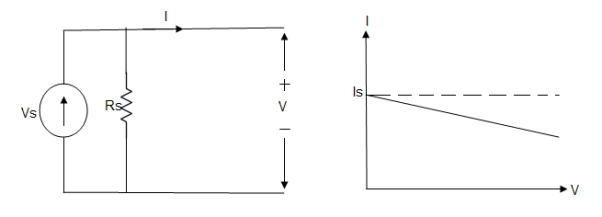 Fig; Practical Current source
The graph represents the current of the current source with respect to time. It is not constant but it also keeps on decreasing as the time passes.
Examples of current and voltage sources The examples of current source are solar cells, transistors and examples of some voltage sources are batteries and alternators.
This was all about ideal and practical sources of power. The ideal sources are very useful for calculations in theory but as ideal sources are not practically possible, only practical sources are used in practical circuits. The batteries we use are a practical source of power and the voltage and current decreases as we use it. Thus both are useful to us in their own ways.
1.3 Kirchhoff’s current and voltage laws
The algebraic sum of currents meeting at a junction or node in a electric circuit is zero ② or the summation of all incoming current is always equal to summation of all outgoing current in an electrical network. Explanation
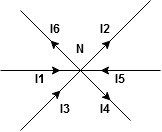
Assuming the incoming current to be positive and outgoing current negative we have    Ie 
Kirchhoff’s Voltage Law (KVL) Statement : the algebraic summation of all Voltage in any closed circuit or mesh of loop zero. Ie ∑ Voltage in closed loop = 0 the summation of the Voltage rise (voltage sources) is equal to summation of the voltage drops around a closed loop in 0 circuit for explanation from here Determination of sigh and direction of currents (Don’t write in exams just for understanding)

Current entering a resistor is +ve and leaving should be –ve Now   
Potential Rise Potential Drop
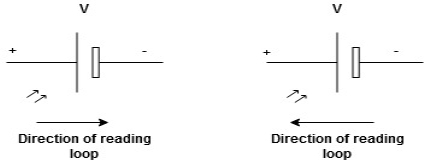 We are reading from +V to –V we are reading from –V to +V    
Given Circuit

First identify no of loops and assign direction of current flowing in loop Note : no of loops in circuit = No, of unknown currents = no, of equations in the circuit

Note : keep loop direction and current direction same ie either clockwise or anticlockwise for all loops I1 I2 Now according to direction of direction assign signs (+ve to –ve) to the resistors
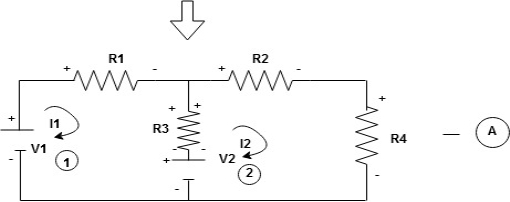
Note : voltage sources (V) polarities does not change is constant. Note: for common resistor between 2 loops appearing in the circuit like R3 give signs according to separate loops as shown
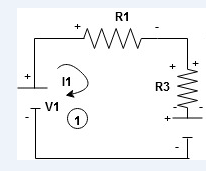
When considering only loop no 1 (+ R3 - )
- B 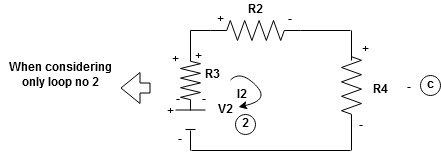
Now consider diagram A and write equations Two loops  
Apply KVL for loop ① [B. Diagram ] (+ to drop -) = - sign and (- to rise +) = + sign  
-  -(      
Similarly for loop no. 2 currents flowing is   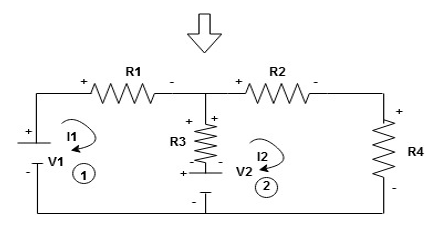 Consider loop no. 1 apply KVL -  -  Consider loop no. 2 apply KVL -  -  After solving equation ① and ② we will get branch current  
1.4 Superposition, Thevenin and Norton Theorems
Statement : the response in any element of linear bilateral network containing more than on sources is the sum of the responses produced by the individual source acting alone. The responses means the voltage across the element or the current in the element The voltage sources should be replaced by short circuit and the current source must be replaced by open circuit .Steps to apply superposition theorem : 1. 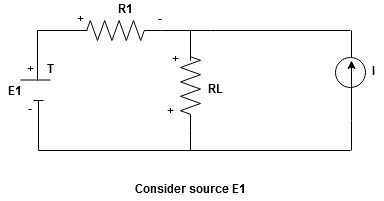 Current sources should be open

Find the current (IL1)(+) through or the voltage across the required element due to the source under consideration using a suitable n/w technique.
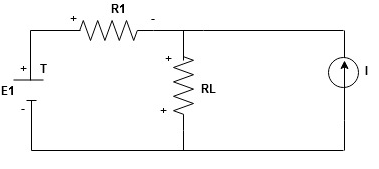 Find the current (ILII)(+) by a suitable network simplification technique
2. Add the individual current IL and ILII by the individual sources acting alone to find total current flowing in load resistance (RL) Ie      Thevenin’s and Norton’s Theorem  Thevenin’s equivalent of A  Norton’s equivalent of A 

CONDITIONS FOR APPLICATION
1.5 Time-domain analysis of first-order RL and RC circuits.
Series R-L circuit:
Fig. shows a series RL circuit connected across a DC source through a switch S.
When switch ‘S’ is close at t>0 the as per KVL network equation will be …
R i(t) + L di(t)/dt = Vs ------------------------------------(1)
|
Above equation is non homogeneous equation linear differential equation of first oder. The solution of equation 1 will give i(t) which consists of two components :
Complimentary function
Which will satisfy di(t)/dt + R/L i(t) =0
Particular integral (if(t)) which will satisfy
R i(t) + L di(t)/dt = Vs
Thus the complete solution wil be
i(t) = in(t) + iJ(t)---------------------------------------(2)
i(t) = Io e –(R/L)t = Io e –(t/ -------------------------------------(3)
-------------------------------------(3)
Where  time constant of RL circuit.
time constant of RL circuit.
Equation (3) provides the natural response where
in(t) = K e –(R/L) t = K e –(t/τ) ----------------------------------(4)
Eq (1) can be written with i(t) = I constnt
RI + L dI/dt = Vs -------------------------------------------(5)
Since I= constsnt
L dI/dt =0
If(t) = I = Vs/R --------------------------------------------(6)
Substitute eq.4 and eq.6 yeilds the solution of eq(1)
i(t) = K e -t/ + Vs/R = K e-t/τ -------------------------------------------(7)
+ Vs/R = K e-t/τ -------------------------------------------(7)
K is determined from initial condition that is t=0 and eq(7) will be
K = -Vs/R = -I ----------------------------------------------------(8)
i(t) = Vs/R (1 – e –(R/L) t)
i(t) = I(1 – e -t/τ) for t>0

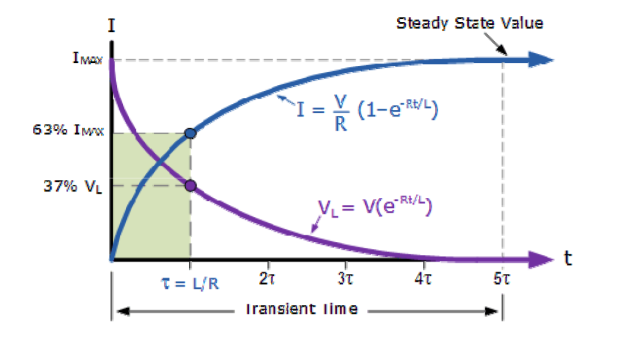
Series RC circuit:

Fig. Shows a series RC circuit connected across a DC source through a switch S.
It is assumed that capacitor voltage id V0 When switch ‘S’ is close at t>0 the as per KVL network
Equation will be …
Vs – R i(t) – vc(t) =0 ------------------------------------------------(9)
For analysis of circuit of the figure the capacitor voltage Vc(t) is chosen as variable .
Substituting i(t) = c dvc(t)/dt in eq(9) we get
Eq(10) is like eq(1) it is also non homogeneous equation linear differential equation
Of first order .
Therefore the solution is similar to eq(1)
Vc(t) = k e -t/τ + Vs ---------------------------------------------(11)
In eq.(11) the time constant is τ = RC
By substituting value of K in eq(11) and after simplification we get --------
Vc(t) = Vo e (-t/τ) + Vs ( 1 – e -t/τ) V for t>0------------------------------------------(12)
The expression for the current in the circuit is given by ---------
i(t) = C dvc(t)/ dt
i(t) = C [ (-1/τ Vo e -t/τ ) + ((-1/τ Vs e -1/τ )]
i(t) = C/RC (Vs – Vo) e -t/τ
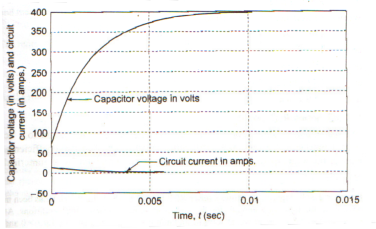
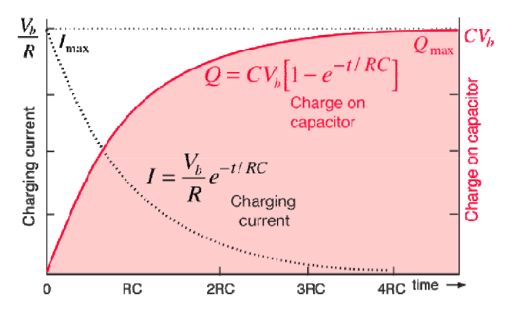
References:
Getting Started in Electronics Book by Forrest Mims
Practical Electronics for Inventors, Fourth Edition Book by Paul Scherz and Simon Monk
Electronics for dummies Book by Cathleen Shamieh and Gordon McComb
